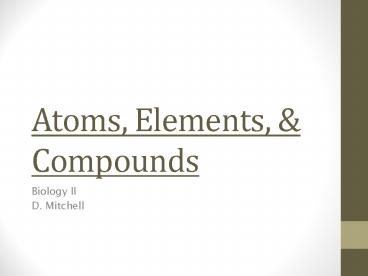Atoms, Elements, - PowerPoint PPT Presentation
1 / 24
Title:
Atoms, Elements,
Description:
Atoms, Elements, & Compounds Biology II D. Mitchell Atom smallest unit of matter that cannot be broken down. Atomic Structure Atoms consist of 3 kinds of subatomic ... – PowerPoint PPT presentation
Number of Views:109
Avg rating:3.0/5.0
Title: Atoms, Elements,
1
Atoms, Elements, Compounds
- Biology II
- D. Mitchell
2
Atom
- smallest unit of matter that cannot be broken
down.
3
Atomic Structure
- Atoms consist of 3 kinds of subatomic particles
- electrons- negatively charged subatomic particles
that occupy the outer electron shells - protons- positively charged subatomic particles
that occupy the nucleus of an atom. - neutrons- subatomic particles that have no charge
(neutral) and occupy the nucleus of an atom.
4
Bohrs Atomic Model
5
Parts of an atom
6
- ATOMS have a neutral charge because of its equal
number of positively charged protons and
negatively charged electrons.
7
- Different energy levels (electron cloud) can hold
a certain numbers of electrons. Atoms are most
stable when the outermost energy level is full!
Electron level of electrons
1 2
2 8
3 18
4 32
5 50
6 72
8
(2)Element
- a substance made of one kind of atom
- can not be broken down to other substances by
chemical means.
9
- 91 elements naturally occur on Earth.
- Life requires about 25 chemical elements.
- Oxygen, Carbon, Hydrogen, and Nitrogen make up
96 of the human bodys mass.
10
- Elements in the Human Body
- Element Symbol Element Symbol
- 1 Oxygen O 6 Phosphorus P
- 2 Carbon C 7 Potassium K
- 3 Hydrogen H 8 Sulfur S
- 4 Nitrogen N 9 Sodium Na
- 5 Calcium Ca
- Most abundant to least abundant
11
Periodic Table of Elements
- Lists the following information
- Name of element
- Symbol
- Atomic number the number of protons. (The
number of protons the number of electrons.) - Atomic mass (Mass Number) the number of protons
plus the number of neutrons in the nucleus.
12
(3) Compound
- substance made of two or more elements bonded
together in a fixed ratio. - represented by a chemical formula that identifies
the elements in the compound and their
proportions. - properties are different from the properties of
the elements that make up the compound
13
Examples
- (1) NaCl -Sodium Chloride
- composed of the elements Sodium(Na) and
Chlorine (Cl) - (2) H2O Water
- composed of the elements Hydrogen(H) and Oxygen
(O) - (3) C3H6O3 Glucose
- composed of the elements Carbon (C), Hydrogen
(H), and Oxygen (O)
14
Chemical Bonds
15
- Atoms are the basic building blocks of matter.
- Atoms join with other atoms to form stable
substances. - The attraction between atoms is a result of their
positive or negative charges. - Atoms join to form compounds and molecules.
16
- Electrons determine whether an atom will bond.
- The number of electrons in the outermost electron
shell(valence electrons) determine how many bonds
can be formed.
17
Oxidation numbers
- indicates the number of electrons lost, gained,
or shared as a result of chemical bonding
18
What is a chemical bond?
- A chemical bond is formed when electrons from two
atoms interact and join.
19
- When atoms with incomplete outer shells interact,
they share, receive (gain), or donate (lose)
electrons.
- Types of Chemical Bonds
- Ionic Bond
- Covalent Bond
- Hydrogen Bond
20
Ionic Bonds
- Occur when one atom gains or loses a valence
electron. - Atoms that lose electrons are positively charged.
- Atoms that gain electrons are negatively charged.
- The oppositely charged ions are attracted to each
other.
21
- Characteristics
- Form between metals and nonmetals
- Ionic compounds tend to form salts.
- Ionic compounds dissolve easily in water .
- Ionic compounds easily conduct electricity.
22
Covalent Bonds
- A COVALENT BOND results when two atoms "share"
valence electrons between them. - This most commonly occurs when two nonmetals bond
together. - Covalent bonds form molecules (O2 , H2) and
compounds (CO2)
23
Hydrogen Bonds
- A hydrogen bond is a bond formed due to a weak
attraction between polar molecules of opposite
charge - As the name "hydrogen bond" implies, one part of
the bond always involves a hydrogen atom. - Hydrogen bonds hold the two strands of the DNA
together.
24
Why are chemical bonds important?
- The type of chemical bond that occurs in a
molecule or substance in part defines its
structure, appearance, and properties. - Example
- NaCl and HCl
- Both contain Cl
- Table salt and hydrogen chloride































